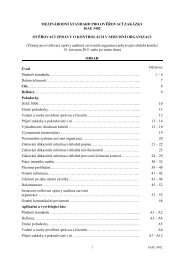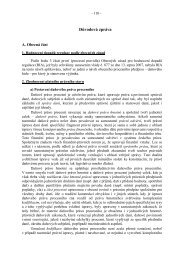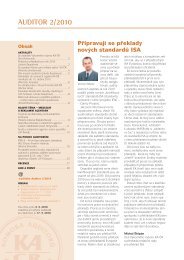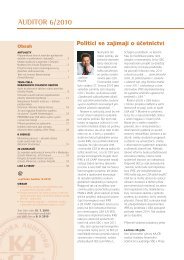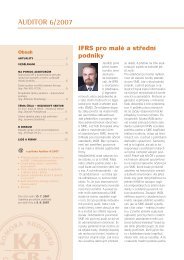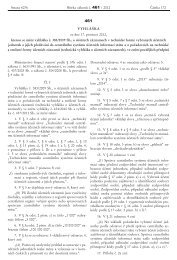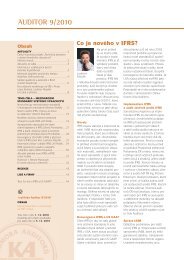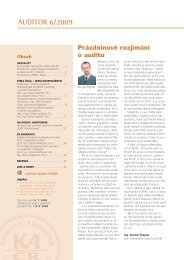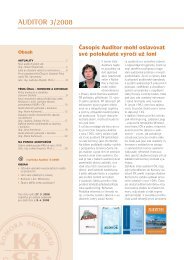Guide to Using International Standards on Auditing in - IFAC
Guide to Using International Standards on Auditing in - IFAC
Guide to Using International Standards on Auditing in - IFAC
You also want an ePaper? Increase the reach of your titles
YUMPU automatically turns print PDFs into web optimized ePapers that Google loves.
164<br />
<str<strong>on</strong>g>Guide</str<strong>on</strong>g> <str<strong>on</strong>g>to</str<strong>on</strong>g> <str<strong>on</strong>g>Us<strong>in</strong>g</str<strong>on</strong>g> <str<strong>on</strong>g>Internati<strong>on</strong>al</str<strong>on</strong>g> <str<strong>on</strong>g>Standards</str<strong>on</strong>g> <strong>on</strong> <strong>Audit<strong>in</strong>g</strong> <strong>in</strong> the Audits of Small- and Medium-Sized Entities Volume 1—Core C<strong>on</strong>cepts<br />
Examples of some events or c<strong>on</strong>diti<strong>on</strong>s that, <strong>in</strong>dividually or collectively, may cast significant doubt about the<br />
go<strong>in</strong>g-c<strong>on</strong>cern assumpti<strong>on</strong> are set out below.<br />
Exhibit 14.2-2<br />
Indica<str<strong>on</strong>g>to</str<strong>on</strong>g>rs<br />
Descripti<strong>on</strong>s<br />
F<strong>in</strong>ancial • Net liability or net current liability positi<strong>on</strong>.<br />
• Fixed-term borrow<strong>in</strong>gs approach<strong>in</strong>g maturity without realistic prospects of<br />
renewal or repayment, or excessive reliance <strong>on</strong> short-term borrow<strong>in</strong>gs <str<strong>on</strong>g>to</str<strong>on</strong>g><br />
f<strong>in</strong>ance l<strong>on</strong>g-term assets.<br />
• Indicati<strong>on</strong>s of withdrawal of f<strong>in</strong>ancial support by credi<str<strong>on</strong>g>to</str<strong>on</strong>g>rs.<br />
• Negative operat<strong>in</strong>g cash flows <strong>in</strong>dicated by his<str<strong>on</strong>g>to</str<strong>on</strong>g>rical or prospective f<strong>in</strong>ancial<br />
statements.<br />
• Adverse key f<strong>in</strong>ancial ratios.<br />
• Substantial operat<strong>in</strong>g losses, or significant deteriorati<strong>on</strong> <strong>in</strong> the value of assets<br />
used <str<strong>on</strong>g>to</str<strong>on</strong>g> generate cash flows.<br />
• Arrears or disc<strong>on</strong>t<strong>in</strong>uance of dividends.<br />
• Inability <str<strong>on</strong>g>to</str<strong>on</strong>g> pay credi<str<strong>on</strong>g>to</str<strong>on</strong>g>rs <strong>on</strong> due dates.<br />
• Inability <str<strong>on</strong>g>to</str<strong>on</strong>g> comply with the terms of loan agreements.<br />
• Change from credit <str<strong>on</strong>g>to</str<strong>on</strong>g> cash-<strong>on</strong>-delivery transacti<strong>on</strong>s with suppliers.<br />
• Inability <str<strong>on</strong>g>to</str<strong>on</strong>g> obta<strong>in</strong> f<strong>in</strong>anc<strong>in</strong>g for essential new-product development or other<br />
essential <strong>in</strong>vestments.<br />
Operat<strong>in</strong>g • Management’s <strong>in</strong>tenti<strong>on</strong>s <str<strong>on</strong>g>to</str<strong>on</strong>g> liquidate the entity or <str<strong>on</strong>g>to</str<strong>on</strong>g> cease operati<strong>on</strong>s.<br />
• Loss of key management without replacement.<br />
• Loss of a major market, key cus<str<strong>on</strong>g>to</str<strong>on</strong>g>mer(s), franchise, license, or pr<strong>in</strong>cipal supplier(s).<br />
• Labor difficulties.<br />
• Shortages of important supplies.<br />
• Emergence of a highly successful competi<str<strong>on</strong>g>to</str<strong>on</strong>g>r.<br />
Other • N<strong>on</strong>-compliance with capital or other statu<str<strong>on</strong>g>to</str<strong>on</strong>g>ry requirements.<br />
• Pend<strong>in</strong>g legal or regula<str<strong>on</strong>g>to</str<strong>on</strong>g>ry proceed<strong>in</strong>gs aga<strong>in</strong>st the entity that may, if<br />
successful, result <strong>in</strong> claims that the entity is unlikely <str<strong>on</strong>g>to</str<strong>on</strong>g> be able <str<strong>on</strong>g>to</str<strong>on</strong>g> satisfy.<br />
• Changes <strong>in</strong> law or regulati<strong>on</strong> or government policy expected <str<strong>on</strong>g>to</str<strong>on</strong>g> adversely affect<br />
the entity.<br />
• Un<strong>in</strong>sured or under<strong>in</strong>sured catastrophes.<br />
The significance of the above events or c<strong>on</strong>diti<strong>on</strong>s often can be mitigated by other fac<str<strong>on</strong>g>to</str<strong>on</strong>g>rs. For example,<br />
the effect of an entity be<strong>in</strong>g unable <str<strong>on</strong>g>to</str<strong>on</strong>g> make its normal debt repayments may be counterbalanced by<br />
management’s plans <str<strong>on</strong>g>to</str<strong>on</strong>g> ma<strong>in</strong>ta<strong>in</strong> adequate cash flows by alternative means, such as by dispos<strong>in</strong>g of assets,<br />
reschedul<strong>in</strong>g loan repayments, or obta<strong>in</strong><strong>in</strong>g additi<strong>on</strong>al capital. Similarly, the loss of a pr<strong>in</strong>cipal supplier may be<br />
mitigated by the availability of a suitable alternative source of supply.




